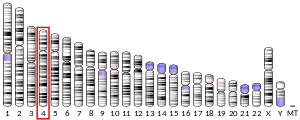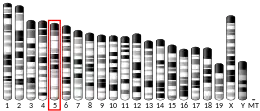| chemokine (C-X-C motif) ligand 6 (granulocyte chemotactic protein 2) | |||||||
|---|---|---|---|---|---|---|---|
| Identifiers | |||||||
| Symbol | CXCL6 | ||||||
| Alt. symbols | SCYB6, GCP-2, CKA-3 | ||||||
| NCBI gene | 6372 | ||||||
| HGNC | 10643 | ||||||
| OMIM | 138965 | ||||||
| RefSeq | NM_002993 | ||||||
| UniProt | P80162 | ||||||
| Other data | |||||||
| Locus | Chr. 4 q21 | ||||||
| |||||||
Chemokine (C-X-C motif) ligand 6 (CXCL6) is a small cytokine belonging to the CXC chemokine family that is also known as granulocyte chemotactic protein 2 (GCP-2). As its former name suggests, CXCL6 is a chemoattractant for neutrophilic granulocytes.[5][6] It elicits its chemotactic effects by interacting with the chemokine receptors CXCR1 and CXCR2.[6] The gene for CXCL6 is located on human chromosome 4 in a cluster with other CXC chemokine genes.[7][8]
References
- 1 2 3 GRCh38: Ensembl release 89: ENSG00000124875 - Ensembl, May 2017
- 1 2 3 GRCm38: Ensembl release 89: ENSMUSG00000029371 - Ensembl, May 2017
- ↑ "Human PubMed Reference:". National Center for Biotechnology Information, U.S. National Library of Medicine.
- ↑ "Mouse PubMed Reference:". National Center for Biotechnology Information, U.S. National Library of Medicine.
- ↑ Proost P, Wuyts A, Conings R, Lenaerts J, Billiau A, Opdenakker G, Van Damme J (1993). "Human and bovine granulocyte chemotactic protein-2: complete amino acid sequence and functional characterization as chemokines". Biochemistry. 32 (38): 10170–7. doi:10.1021/bi00089a037. PMID 8399143.
- 1 2 Wuyts A, Van Osselaer N, Haelens A, Samson I, Herdewijn P, Ben-Baruch A, Oppenheim J, Proost P, Van Damme J (1997). "Characterization of synthetic human granulocyte chemotactic protein 2: usage of chemokine receptors CXCR1 and CXCR2 and in vivo inflammatory properties". Biochemistry. 36 (9): 2716–23. doi:10.1021/bi961999z. PMID 9054580.
- ↑ Modi W, Chen Z (1998). "Localization of the human CXC chemokine subfamily on the long arm of chromosome 4 using radiation hybrids". Genomics. 47 (1): 136–9. doi:10.1006/geno.1997.5100. PMID 9465307.
- ↑ O'Donovan N, Galvin M, Morgan J (1999). "Physical mapping of the CXC chemokine locus on human chromosome 4". Cytogenet Cell Genet. 84 (1–2): 39–42. doi:10.1159/000015209. PMID 10343098. S2CID 8087808.
This article is issued from Wikipedia. The text is licensed under Creative Commons - Attribution - Sharealike. Additional terms may apply for the media files.



